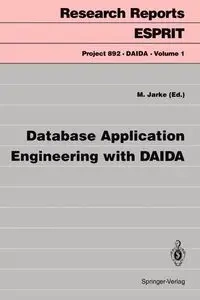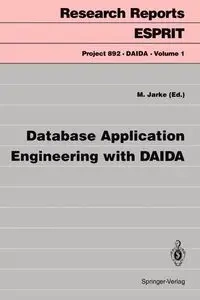Database Application Engineering with DAIDA - Jarke Matthias
Database Application Engineering with DAIDA - Jarke Matthias
EAN: 9783540562917
Marka
Symbol
252HKJ03527KS
Rok wydania
1993
Strony
572
Oprawa
Miekka
Format
15.6x23.4cm
Redakcja
Jarke Matthias
Język
angielski

Bez ryzyka
14 dni na łatwy zwrot

Szeroki asortyment
ponad milion pozycji

Niskie ceny i rabaty
nawet do 50% każdego dnia
Niepotwierdzona zakupem
Ocena: /5
Marka
Symbol
252HKJ03527KS
Kod producenta
9783540562917
Rok wydania
1993
Strony
572
Oprawa
Miekka
Format
15.6x23.4cm
Redakcja
Jarke Matthias
Język
angielski

In the early 1980s, a trend towards formal undeIStanding and knowledge-based assistance for the development and maintenance of database-intensive information systems became apparent. The group of John Mylopoulos at
the UniveISity of Toronto and their European collaboratoIS moved from semantic models of information systems design (Taxis project) towards earlier stages of the software lifecycle. Joachim Schmidt's group at the University of
Hamburg completed their early work on the design and implementation of database programming languages (Pascal/R) and began to consider tools for the development of large database program packages. The Belgian company BIM
developed a fast commercial Prolog which turned out to be useful as an implementation language for object oriented knowledge representation schemes and as a prototyping tool for formal design models. Case studies by Vasant
Dhar and Matthias Jarke in New York pointed out the need for formally representing process knowledge, and a number of projects in the US and Europe began to consider computer assistance (CASE) as a viable approach to support
software engineering. In 1985, the time appeared ripe for an attempt at integrating these experiences in a comprehensive CASE framework relating all phases of an information systems lifecycle. The Commission of the European
Communities decided in early 1986 to fund this joint effort by six European software houses and research institutions in the Software Technology section of the ESPRIT I program. The project was given the number 892 and the
title DAIDA - Development Assistance for Intelligent Database Applications.
EAN: 9783540562917
EAN: 9783540562917
Niepotwierdzona zakupem
Ocena: /5
Zapytaj o produkt
Niepotwierdzona zakupem
Ocena: /5
Napisz swoją opinię

